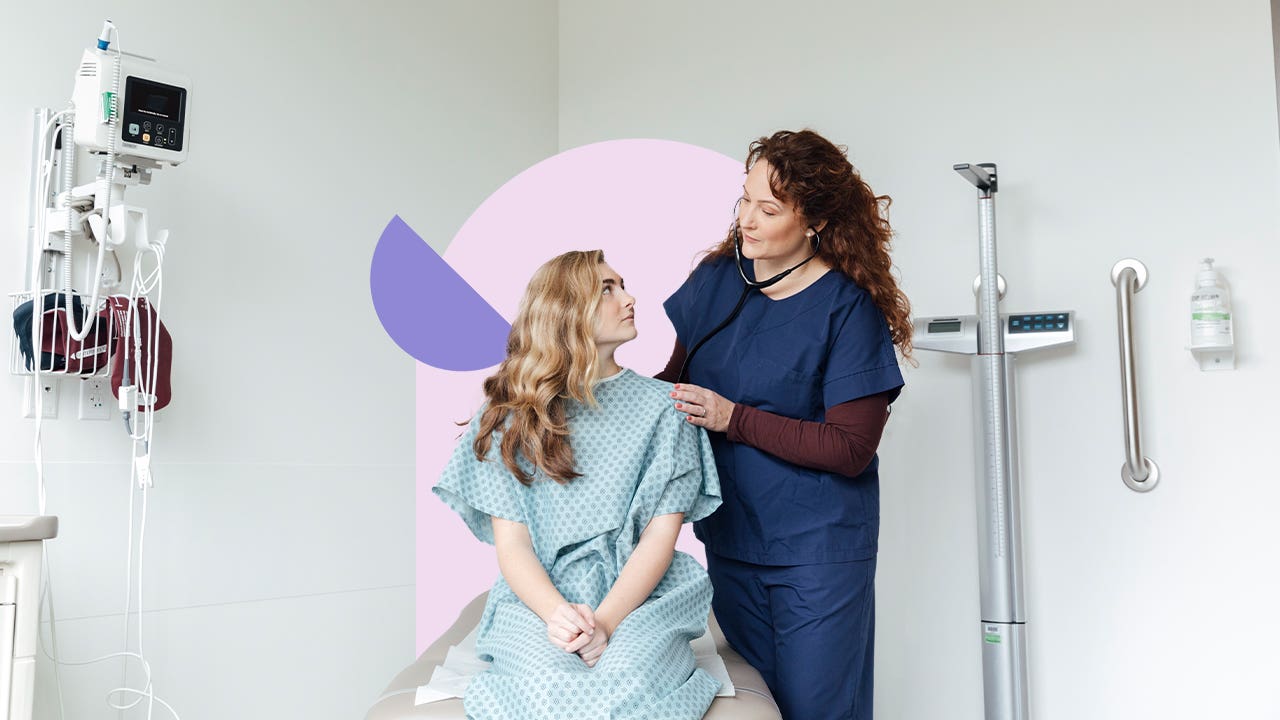Out-of-pocket healthcare: Average costs and how to finance them

The Bankrate promise
At Bankrate we strive to help you make smarter financial decisions. While we adhere to strict , this post may contain references to products from our partners. Here's an explanation for .
Health insurance can take away some of the sting of medical bills, but even with insurance, many necessary healthcare events can involve large out-of-pocket costs. The latest data published by Peterson-KFF, found that out-of-pocket healthcare spending increased by 10.3 percent, year-over-year — a trend that’s likely to continue as prices soar thanks to high inflation.
If healthcare costs get too high for you to comfortably afford, you may need help financing out-of-pocket costs. Some possible options include using a personal loan to cover additional expenses or even a debt consolidation loan to combine multiple debts.
Healthcare costs statistics
- Out-of-pocket healthcare costs have increased by 10.3%, year-over-year, according to Peterson-KFF.
- Roughly 30 million Americans are uninsured.
- Alaska and Wyoming have the highest percentage of uninsured Americans, with 12.2% and 12.3% of uninsured individuals, respectively.
- American-Indian and Alaska Natives, as well as Hispanics, are more likely to be uninsured than other segments of the population, with an uninsured rate of 21.7% and 20%, respectively.
- An average three-day hospital stay in the U.S. costs about $30,000. This alone could put uninsured individuals at risk of bankruptcy and financial ruin.
- In some states, like Louisiana, Vermont and West Virginia, health insurance costs can eat away over 15% of an individual’s paycheck.
- Last year, the average U.S. employee paid $1,763 out-of-pocket before hitting their deductible.
- Roughly 1 in 10 Americans have medical debt, with millions owing a balance upwards of $10,000.
- About one in six Americans use personal loans to pay for medical bills.
How healthcare works
Many Americans, even those with employer-sponsored healthcare coverage, are susceptible to high levels of medical debt. On top of paying a premium each month, the individual must pay a set amount out-of-pocket before the coverage — also known as the deductible — kicks in. While coverage results in lower costs for in-network providers and prescriptions, an unexpected medical bill can take years to pay off.
According to a recent Kaiser Institute survey, 24 percent of adults surveyed said they currently have medical or dental debt they’re unable to pay off. The situation is even worse for uninsured Americans, who often use personal loans or credit cards, which can have interest rates upwards of 20 percent, to finance their expenses.
However, how people finance their medical debt is nuanced and based on factors such as gender, socioeconomic status and race. The KFF survey found that those with a higher income are more likely to take out a personal loan, while those with lower incomes are more likely to borrow the funds from family members or friends.
Financial effects of healthcare
When it comes to Americans with health insurance — both public and private — those aged 65 and over are the population with the most insurance coverage. In contrast, those between the ages of 26 and 34 have the least coverage.
Here are the percentages of Americans with health insurance in 2021, from those who fall in the 0-18 year age range, to individuals 65 years of age and older.
| Age | % of people insured |
|---|---|
| 0-18 | 94.6% |
| 19-25 | 86.1% |
| 26-34 | 85.0% |
| 35-44 | 87.2% |
| 45-54 | 89.2% |
| 55-64 | 91.8% |
| 65+ | 99.2% |
When the American Cares Act (ACA) was implemented in 2010, it helped narrow the disparities in health insurance coverage; however, it didn’t eliminate it completely. The latest report by the State Health Access Data Assistance Center (SHADAC) found that people of color are more likely to remain uninsured when compared to their white counterparts.
Here’s how the health coverage disparities play out in the country by race.
| Race | % of people covered |
|---|---|
| White | 94.3% |
| Black or African American | 90.4% |
| Hispanic or Latino | 82.4% |
| Asian | 94.2% |
| Other/multiple races | 91.3% |
People can be uninsured for many reasons, but some of the most common include:
- They don’t think they can afford health insurance, even with subsidies.
- Their employer does not offer health insurance and they do not know how to find it from another source.
- Signing up for insurance can be difficult or confusing.
- They don’t think they need insurance.
- They can’t find an insurance plan that meets their needs.
Out-of-pocket healthcare costs
Deciphering all of the out-of-pocket terms and what they mean for your wallet can be confusing, so we’ve broken down the most common terms that you can expect on your next medical bill.
- Coinsurance
- The percentage of the medical costs you pay after meeting your deductible.
- Copay
- A fixed fee you pay when getting in-network healthcare care or prescription medication.
- Deductible
- The amount you need to pay in covered healthcare services out-of-pocket before your insurance begins to pay.
- Premium
- The amount deducted monthly from your paycheck to pay for your insurance. The amount you pay will depend on your employer and the health insurance plan you choose.
The share of healthcare spending in the country is greatly dependent on age and health status. A KFF analysis found that only two percent of people in the U.S. reported being in poor health; however, the numbers change drastically as people age, with 20 percent of those over 65 reporting their health as “fair” or “poor.”
Peterson-KFF’s Health System Tracker found that individuals aged 55 and older hold the largest share of the amount spent on healthcare. Despite only making up 30 percent of the population, this age group accounted for 56 percent of the total health spending in recent years.
| Age | Avg. share of spending |
|---|---|
| 0-18 | 9% |
| 19-34 | 12% |
| 35-44 | 9% |
| 45-54 | 13% |
| 55-64 | 21% |
| 65+ | 35% |
Out-of-pocket spending and costs fell dramatically during the COVID-19 pandemic. However, recent studies have found that the average out-of-pocket costs are increasing as people begin seeking regular healthcare again. According to Third Way, millions of working-age American families spend over 5 percent of their household income on out-of-pocket healthcare costs each year. Given that the average household income in the U.S. is $87,864, as of 2023, that means the average American family spends at least $4,393 in these expenses each year.
Ways to finance-out-pocket costs
While health expenses can be high, you may be able to finance these costs through one or more ways.
A personal loan
People often resort to using personal loans to finance large or unexpected medical bills after discussing all of their payment options with the hospital. Lenders may disburse the funds within a few days of approval, and depending on your credit, the interest rate is often lower than other financing options. However, you’ll be on the hook for years of monthly payments.
Credit cards
If you get hit with a smaller bill that you need immediate funds for, turning to a credit card could be a good way to pay off your medical bills. Keep in mind, though, that financing large amounts on a credit card can lead to significant high interest debt should you not be able to make the monthly payments.
A payment plan
Personalized payment plans are common among doctors, hospitals and other medical providers. These plans break up a larger sum into smaller amounts that are paid off over time. While these plans are ideal for those with smaller bills, consumers with higher medical bills could find themselves with years of large monthly payments.
A HELOC
A home equity line of credit (HELOC) allows homeowners to borrow against the amount of equity they’ve built up in their home. Depending on the amount of wealth you’ve accumulated, taking out a HELOC can help finance high amounts of medical debt. However, you need to keep up with the monthly payments to avoid losing your home.
Frequently asked questions
-
According to Mercer, an HR consultancy, healthcare costs with employer-sponsored plans are forecasted to rise an average of 5.6 percent in 2023. These increases are likely due to record-breaking inflation and increased medical activity following the peak of the coronavirus as patients begin resuming their yearly and non-emergency appointments.
-
An out-of-pocket maximum is the most you’ll pay for in-network healthcare services in a year before hitting your deductible. Your maximum amount depends on the plan, but there is a set limit as to how high your insurance company can set the maximum.For example, the 2023 out-of-pocket maximum cannot exceed $9,1000 for an individual plan and $18,200 for a family plan.
-
Before making the decision to finance medical expenses with a personal loan, it’s important to know how much you’ll be paying in interest over the life of the loan.To calculate the potential interest rate of your loan, you can use a calculator or you can use this formula: Principal loan amount x Interest rate x Time (number of years in repayment) = how much interest you’ll pay over time.
Related Articles



